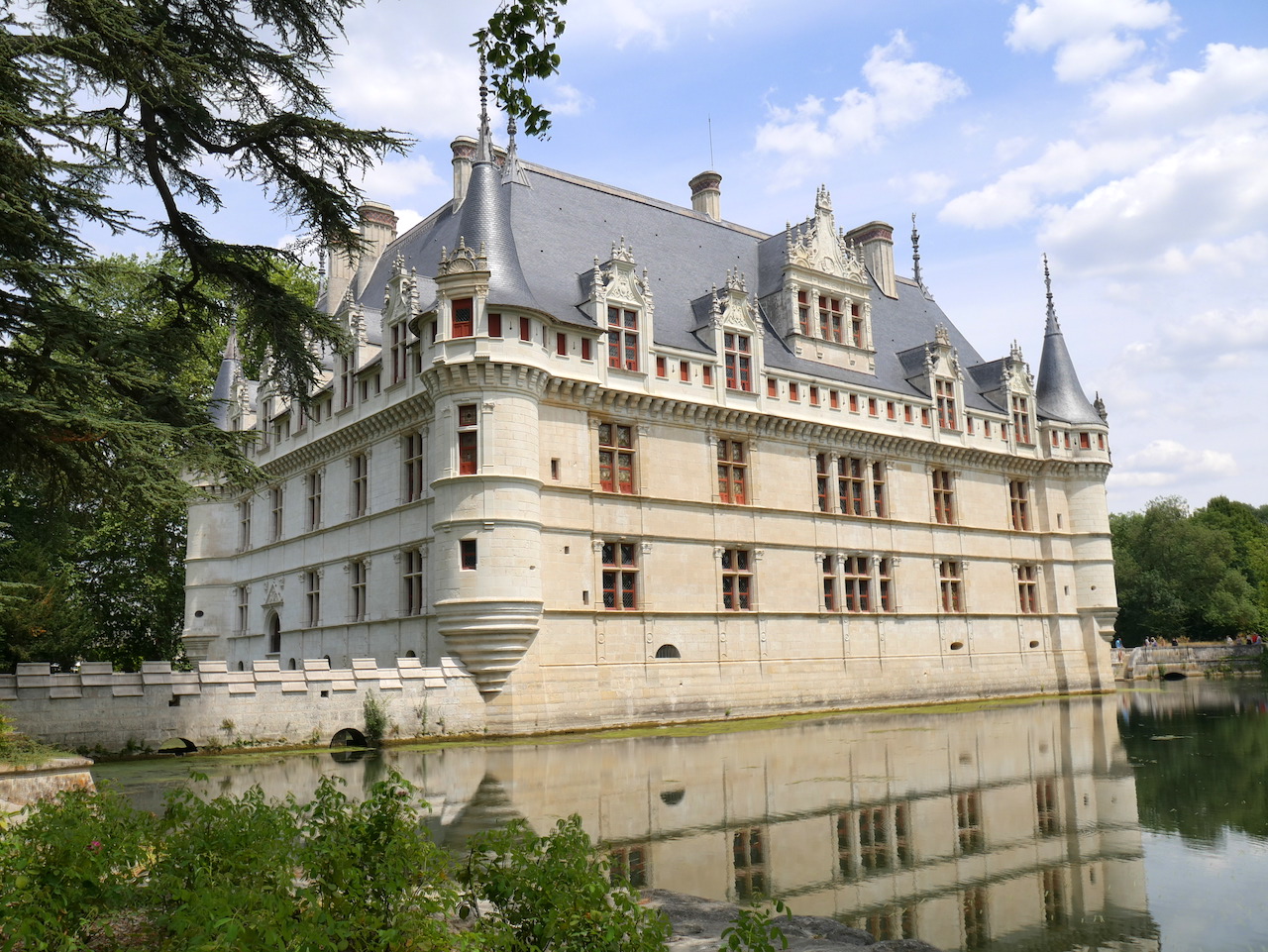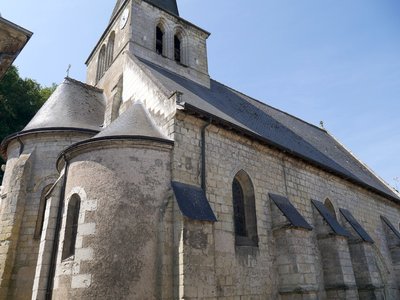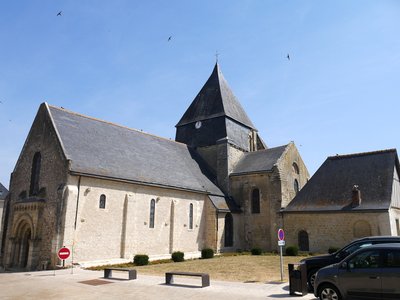Tours to Azay-le-Rideau

Centre-Val de Loire
9. Tours to Azay-le-Rideau
Medium
7h30
30km
+259m
-270m
Step
Embed this item to access it offline
Leaving the basilica of Saint-Martin de Tours, you follow the Cher river to Savonnières where you climb the hundred steps behind the church to go through the Touraine landscapes. The visit of the castle of Villandry with its park is recommended, the Via Columbani follows the southern part of the park but high hedges of plants forbid any view of the estate. Be observant of the many cellars carved in the rock are visible from the Via Columbani. Forests, meadows and cereal fields follow one another throughout the peregrination. You will arrive in Azay-le-Rideau, watered by the river Indre, a charming town with the charm of the Touraine region and its admirable renaissance castle.
4 points of interest

Église Saint-Gervais et Saint-Protais à Savonnières - Amis saint Colomban TouristÉglise Saint-Gervais and Saint-Protais Church in Savonnières
Die Kirche Saint-Gervais und Saint-Protais stammt aus dem 12. Jahrhundert, sie ist bemerkenswert für ihre architektonische Einheit im Zisterzienserstil und ihr Portal im Saintongeais-Stil.
1138 schenkte Hugues, Erzbischof von Tours, die Kirche der Abtei von Toussaint d'Angers.
Der ursprüngliche Grundriss des Gebäudes bestand aus einem Kirchenschiff und einem nördlichen Seitenschiff, dessen dritter Erker von einem anjianischen Gewölbe mit Rippen und Lilienen bedeckt ist.
Das Seitenportal ist von Poitevin inspiriert und hat drei Archivolten, die mit Akanthusblättern, Dämonen und fantastischen Tieren, Chimären und Greifen verziert sind. Es wurde 2006 restauriert.
Informationstafel am Chevet der Kirche.
Château de Villandry - Amis saint Colomban HistoricalVillandry Castle
Throughout the Middle Ages and until the beginning of the 17th century, the domain of Villandry was called Coulombiers or Colombiers and was none other than the seat of a châtellenie under the authority of the castle of Tours.
Living around 1080, Geoffroy le Roux, also lord of Cravant-les-Côteaux, was the first lord of Colombiers.
The fortified castle of Villandry was modified for the first time after the Hundred Years' War in a new search for comfort and healthy living. In particular, fireplaces were installed in most rooms and most of the walls were pierced with numerous mullioned windows. This artistic revival marked by the development of luxury and pomp was not only the result of the influence of the patronage of the Dukes of Burgundy and Duke Jean de Berry.
All that remains of the medieval building today are the foundations and the 12th century keep, modified in the 14th century, which can still be guessed, enclosed in one of the wings of the main courtyard.
The last of the great castles that were built on the banks of the Loire in the 16th century, the current castle of Villandry, brings a final touch to the research at the beginning of the Renaissance while announcing the achievements of the castles of Ancy-le-Franc and Écouen.
More info at: Wikipedia
To visit the castle
Église Saint-Étienne de Villandry - Amis saint Colomban TouristSaint-Etienne Church in Villandry
The church of Villandry is dedicated to Saint Stephen, the first martyr. The first chapel known as Saint Roch dates back to the 5th century (it was destroyed around 1844). It is built halfway up the hillside, is located more than 300 m from the castle and is far from the alluvial plain of the Cher, without any risk of flooding. By its physiognomy, it finds its counterpart with the parish church of Cormery.
A rectangular chapel measuring 9m by 18m was built in the 11th century. At the end of the 12th century, the transept and the choir were added. The original chapel then became the nave of the new church.
Église Saint-Symphorien à Azay-le-Rideau - Amis saint Colomban TouristSaint-Symphorien Church in Azay-le-Rideau
When you arrive on the square in front of the Saint-Symphorien church in Azay-le-Rideau, you immediately notice the originality of the double gable. The one on the right, Romanesque, is very different from the one on the left, more recent, with a basket-handle portico.
The oldest mention of the building dates back to the 11th century charter by which Geoffroy de l'Île donated it to Cormery Abbey. This donation concerns a small church which is written as abandoned. Archaeologists date certain decorative elements of the old gable from the Carolingian Renaissance period.
The main nave, to the south, is from the 11th century; however the pointed arches and the vaults with ridges are from the 12th century. The side nave from the bell tower to the apse dates from the same period. Mural frescoes were highlighted in 1997 in the choir, which was originally fully decorated.
In the 16th century two bays completed the side nave to lead it to a new gabled façade adjoining the old "basket-handle" façade and a vast bay in the flamboyant style.
The side chapel -chapel of the chateau- was built in 1603. This chapel is located at the back of the church to the right of the last bay before the choir.
Text source: information document available in the church from the Dictionnaire géographique, historique et biographique d’Indre-et-Loire par J.-X. Carré de Busserolles, Tours, 1878 et Souvenirs du temps passé de Georges Jéhan, Tours, 1928
Description
You leave the Saint-Martin Basilica by rue Descartes, second street on the right, rue Nericault Destouches, on the left, Place Gaston Paillhou, at the crossroads straight ahead, rue Chanoineau, cross boulevard Béranger, rue Jehan Fouquet, third street on the right, rue d'Entraigues, on the left, rue Lakanal for 1000 meters, on the right at the junction with rue Stéphane Pitard, on the left rue Auguste Chevallier, cross the Saint-Sauveur roundabout, take the bridge to cross the Cher,
- First street on the right, rue du Pont aux Oies, follow the Cours du Cher on a dirt road.
- Pass under the D37, first tarmac road on the right, continue along the Cher on the cycle path.
- In Saint-Gervais-et-Saint-Protais, take the stairs at the church, turn right to go around the cemetery, take the asphalt road, impasse des Verreries, turn right at the junction with rue Chaude, route de la Boisserie, stay on your left to go around the hamlet of la Boisserie.
- After 400 meters turn right on a dirt road, right on a tarmac road, follow the park of Villandry.
- At the crossroads turn right rue de la Mairie, first left, cross the square, rue de Munat, les Aubuis
- At the exit Le Haut Munat turn left then right on a dirt road, straight ahead at the crossroads with an asphalt road, third road on the left, take the bridge over the A 85, stay on your left, Le Moulin Mocrat, exit la Robichère, road on the right,
- Cross the D 321, stay on your right as you leave the edge of the wood and enter the wood, straight ahead at the crossroads rue de la Vallée du Vau. At the second crossroads on the left, take the second road on the right.
- Left junction with D 39, road on the right before the level crossing, first road on the left again at the crossroads.
- Left at the junction then left at the farm sheds, rue des Fontaines
- On the left at the crossroads, take the underground under the D 751, rue Tournois, rue Nationale, third street on the left, rue Gambetta, on the right you arrive at the Saint-Symphorien church of Azay-le-Rideau.
- Departure : Saint Martin's Basilica, 1 Rue Descartes, 37000 Tours
- Arrival : Saint-Symphorien Church, Place du 11 Novembre 1918, 37190 Azay-le-Rideau
- Towns crossed : Centre-Val de Loire
Altimetric profile
Transport
Gare Azay-le-Rideau ligne TER Tours-Chinon
Report a problem or an error
If you have found an error on this page or if you have noticed any problems during your hike, please report them to us here:








